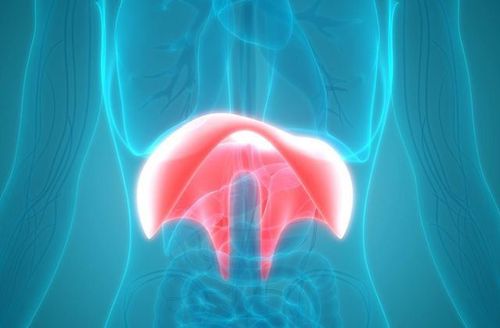This is an automatically translated article.
The article was professionally consulted by Doctor Tran Quoc Tuan - Head of the ICU - ICU - Emergency Resuscitation Department - Vinmec Phu Quoc International General HospitalThe respiratory system plays an important role in human health and life. Each person can learn on their own how to breathe properly to keep the diaphragm as well as the entire respiratory system healthy. There are many ways to breathe to help keep the respiratory system healthy, in the following article, we will introduce you to the most effective and basic breathing exercises.
1. How does correct breathing help strengthen the diaphragm?
In the human body, the diaphragm is the main respiratory muscle that plays a role in maintaining regular and continuous breathing. If the diaphragm is not functioning properly, it will cause poor ventilation in the lungs, leading to overworked compensatory work in the accessory respiratory muscles. Practicing diaphragmatic breathing will help increase the efficiency of breathing movements, help the respiratory system work efficiently and save energy.Patients with chronic obstructive pulmonary disease, due to the accumulation of air in the lungs causing the chest to swell or other chronic lung diseases should also perform this exercise, to increase the activity of the diaphragm.

Cơ hoành có chức năng duy trì hoạt động hô hấp
2. Breathing exercises to strengthen the diaphragm
2.1 Basic breathing exercises
Basic breathing exercises that do not require combined limb movements or equipment:Respiratory muscle relaxation
Can be performed in a supine or sitting position. First, adjust your head and back straight, feet touching the ground, be careful not to do it when leaning on the chair. Place 2 hands on top of valve on both sides. Rotate your arms and elbows from front to back, then back. Perform exercises from 10 to 20 reps each time, perform 2-3 sets of exercises per day, each batch from 2 to 3 times. Pursed-lip breathing
Can be performed in a supine or sitting position. Breathe in slowly through the nose at first, then blow out through the mouth like a whistle. Perform exercises from 10 to 20 reps each time, perform 2-3 sets of exercises per day, each batch from 2 to 3 times. Chest breathing
Can be performed in a supine or sitting position, with one hand on the chest. Breathe in slowly through the nose at first, expanding the chest, then blowing out through the mouth like a whistle, the chest collapses. Perform exercises from 10 to 20 reps each time, perform 2-3 sets of exercises per day, each batch from 2 to 3 times. Belly breathing
Can be performed in a supine or sitting position, with one hand on the chest. Breathe in slowly through the nose at first, expand the belly, then blow out through the mouth like a whistle, the abdomen collapses. Perform exercises from 10 to 20 reps each time, perform 2-3 sets of exercises per day, each batch from 2 to 3 times.
2.2 Breathing exercises combined with movement
Some exercises:Breathing combined with hand movements
Can be performed in a supine or sitting position, lying on your side with extra pillows placed under the abdomen. Thus, the right lung area will increase and expand better. Initially, inhale through the nose slowly, while raising your arms. Then blow out through your mouth like a whistle, while lowering your hands. Perform exercises from 10 to 20 reps each time, perform 2-3 sets of exercises per day, each batch from 2 to 3 times. Breathing combined with leg movement
Perform in a supine position, relax your arms and legs. Initially, inhale slowly through the nose, while bringing the left leg up. Then exhale through your mouth while lowering your legs. Switch legs do the same. Perform exercises from 10 to 20 reps each time, perform 2-3 sets of exercises per day, each batch from 2 to 3 times. Instrumental breathing
Perform in a supine or sitting position. At first, take the tip of the tube completely into your mouth, taking in a long, slow breath. Try to hold the breath for as long as possible, until the exhalation is normal. Do 5 - 6 breaths like this each time, do 2-3 sets of exercises per day, 2-3 times each. Practice breathing with steps
Perform walking, combined with breathing 1 - 3 or 2 - 4. That is, one step in and three steps out, or two steps in and four out.
Technique to clear congestion
Sneeze : is a protective reflex. Take a deep breath, then close the glottis, open the glottis, and exhale quickly through the nose and mouth. Cough: is a reflex that protects the underlying airways. Take a deep breath, then close the epiglottis, open the glottis, and breathe rapidly through the mouth.

Tập thở giúp cơ hoành khỏe
3. Note when practicing breathing to help strengthen the diaphragm
For the exercise to be highly effective, it should be noted:Should practice diaphragmatic breathing several times a day until it becomes a habit. At first, you can practice 5-10 minutes each time, 3-4 times a day and then gradually increase the time to practice. After mastering the diaphragmatic breathing technique in one position, you should practice changing positions, practicing when standing, walking and even working.
Please dial HOTLINE for more information or register for an appointment HERE. Download MyVinmec app to make appointments faster and to manage your bookings easily.













